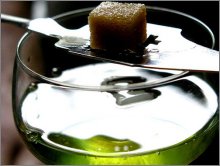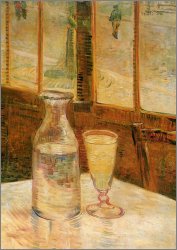All About Absinthe:
Its History, Effects, Laws and More in Brief
by www.SixWise.com
In late 19th-century Europe and early 20th-century United
States, absinthe was all the rage. This 140-proof, bitter-tasting
green liqueur was fancied by artists, poets and intellectuals
alike. Vincent van Gogh, Paul Gaugin, Pablo Picasso, Oscar
Wilde, Charles Baudelaire, and Edgar Allan Poe all fondly
partook in "the green fairy."
|

Absinthe is traditionally prepared by pouring 1 ounce
of the spirit into a glass, placing a slotted spoon
over the top and slowly pouring ice cold water over
it. This turns the mixture a milky color. Sometimes
a sugar cube is placed on top of the spoon and allowed
to dissolve into the mixture as well.
|
Ernest Hemingway was also a notable absinthe drinker, and
his now famous cocktail recipe, "Death in the Afternoon,"
which he contributed to a collection of celebrity recipes
in 1935, has been widely circulated. Hemmingway wrote:
"Pour one jigger absinthe into a Champagne glass.
Add iced Champagne until it attains the proper opalescent
milkiness. Drink three to five of these slowly."
First made in 1792 in Switzerland, absinthe was initially
used as a medicinal tonic for stomachaches, but soon took
on a more recreational allure. It is made from herbs including
fennel, anise, and Artemisia absinthium, or wormwood, the
ingredient from which absinthe gets its name -- and mystique.
Wormwood contains a chemical called thujone. This is the
constituent that gives absinthe its evergreen fragrance and
causes it to become cloudy when it's diluted. It's also the
active ingredient that was blamed for "absinthism"
-- the nervous or mental disorder that was said to result
from drinking too much absinthe.
In the 19th century, absinthism was thought to cause hallucinations,
mental problems and criminal activity (and was even a theory
for why Van Gogh may have cut his ear off).
|

Vincent van Gogh's "Still Life With Absinthe."
(Paris 1887)
|
"It is truly madness in a bottle, and no habitual drinker
can claim that he will not become a criminal," one U.S.
politician is reported to have said according to Wired.com.
The turning point came in 1905 when a Swiss farmer reportedly
killed his pregnant wife and two daughters after drinking
two glasses of the "green menace" (although he had
also drank crème de menthe, cognac, seven glasses of
wine plus a full liter of wine, and coffee with brandy, according
to Wired).
Soon after, the beverage was made illegal.
The Resurfacing of Absinthe
You may have spotted absinth, absinthe essence or another
similar product on the market and wondered if it's the real
thing. The truth is, absinthe has been popping up all over
the market, in quality and not-so-quality forms, ever since
new food regulations were adopted by the European Union in
1988.
The regulations inadvertently left out absinthe, and new
distilleries began to produce the re-legalized beverage (although
some maintain that many of the newer absinthes are not as
good as the pre-ban versions).
Just as in the past, absinthe once again became popular among
artists and celebrities, with Marilyn Manson and Johnny Depp
both speaking of its virtues.
What about absinthism and the effects of thujone? It turns
out that this hallucinatory illness may have been nothing
more than common alcohol poisoning, according to a study by
a German researcher, Dirk W. Lachenmeier, and colleagues.
He tested the thujone concentrations in absinthes produced
according to historic 19th-century recipes, as well as in
vintage absinthe. What he found was that they contained either
relatively low concentrations of thujone, or levels that were
not even detectable. Lachenmeier concluded that absinthe is
no more harmful than any alcoholic spirit, and that "absinthism"
was likely alcohol poisoning (as some absinthe can be nearly
double the strength of typical alcoholic beverages).
Interestingly, U.S. law now allows absinthe that contains
less than 10 parts per million of thujone. According to Lachenmeier's
study, the historic absinthes that he tested would also conform
to these maximum limits.
If you decide to test out some absinthe for yourself, remember
to do so responsibly: absinthe can contain up to 70 percent
alcohol. And, try to answer Oscar Wilde's notorious question,
"What difference is there between a glass of absinthe
and a sunset?"
Recommended Reading
Alcohol
and Alcoholism in the U.S. -- The Shockingly High Numbers
Revealed
How
True IS the Phrase 'In Vino Veritas' ('In Wine There Is Truth')?
Sources
Forensic
Science International Volume 158, Issue 1, 20 April 2006,
Pages 1-8
Substance
Abuse Treatment, Prevention and Policy May 10, 2006
Wired.com
November 2005